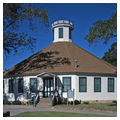Often beginning as small outposts surrounded by farms or ranches, towns were established throughout nineteenth-century Texas that not only provided the infrastructure necessary for a functional society but also included important social outlets. A typical town center initially included four buildings: a store, a post office, a church, and a dance hall. The dance hall served as a general community center, where dances as well as meetings, festivals, feasts, weddings, and other celebrations took place.
Dance halls in Texas, particularly those built prior to World War II, tend to resemble barns from the outside. They were almost always constructed of wood frame with clapboard or, less frequently, board-and-batten siding. Hinged flaps cut into the siding served as windows and could be opened to allow airflow into the building; rising hot air was vented through a cupola at the roof's peak. The interiors were originally a single large room, with an elaborate truss structure supporting the roof. Sometimes a single center post or multiple posts provided support for this superstructure. The wooden dance floor in the hall was maple or oak, usually laid in two-and-a-quarter-inch strips, and some halls featured a slightly raised deck around the perimeter of the dance floor with bench seating. Over the years, additions of kitchens, bars, seating areas, restrooms, stages, and other accretions have expanded these buildings beyond the original dance floor.
Eighteen known dance halls were built with a “round” or polygonal, nonorthogonal plan. The design was first conceived by Austin County carpenter Joachim Hintz in 1897 for the twelve-sided Bellville Turnverein Pavilion. For the next forty years, variations on the building type were constructed exclusively in Central and South Texas farming communities settled by German and Czech immigrants. These structures were probably based on the octagonal barn plans promoted heavily in the agricultural press at the end of the nineteenth century, yet they look nothing like the round barns of New York and New England or the domed masonry dairy barns of the upper Midwest. This building type is unique to Texas, particularly since cattle barns are little used and the building type has been transformed to entertainment use. The majority of the state's six-, eight-, and twelve-sided dance halls were built in a line along TX 36 and the Gulf, Colorado and Santa Fe Railway.
Many of the halls were built by immigrant organizations, such as the Sons of Hermann or Knights of Pythias lodges, German athletic clubs Turnvereins or shooting clubs Schuetzen Vereins, and Czech lodges of the KJT Katolicka jednota Texaska, or Catholic Union of Texas and SPJST Slovanská podporující jednota statu Texas, or Slavic Benevolent Order of the State of Texas. Agricultural societies, singing societies, and other clubs and fraternal organizations also built dance halls, as did individuals. Many of these halls are still standing today, in large part because the cultural traditions of their communities have been preserved and the organizations that built the halls remain active.
The history of country-western music is inextricably tied to Texas dance halls. Bob Wills and the Texas Playboys, George Jones, Willie Nelson, George Strait, Asleep at the Wheel, and countless other musical pioneers developed and refined their sound in these halls while patrons whirled around the floor, dancing polkas and the Texas Two-Step. Other musical genres figure prominently in the story of Texas dance halls as well: the music of German and Czech polka bands, still active on the dance hall circuit today, merged with the music of Mexico to create the sound known as norteño or conjunto, and Louisiana zydeco music made its way into Texas through dance halls in the eastern part of the state.
Today, Texas dance halls face the same challenges that threaten many other rural commercial or institutional buildings. As the population of Texas shifts from rural to urban areas, dances and live music performances face competition from other activities for people's time and money. And as the rural population ages, the organizations that have traditionally supported and managed these venues are faced with declining memberships. In addition, deferred maintenance, moisture issues, and out-of-date electrical and mechanical systems threaten many of these structures.
Texas dance halls have served as centers of community life throughout the state, simultaneously preserving cultural and social traditions even as they have been a melting pot for the various ethnic groups who settled here. In recent years, individuals and organizations have begun to recognize the importance of these buildings, which bodes well for the long-term preservation of these uniquely Texan buildings.
Writing Credits
If SAH Archipedia has been useful to you, please consider supporting it.
SAH Archipedia tells the story of the United States through its buildings, landscapes, and cities. This freely available resource empowers the public with authoritative knowledge that deepens their understanding and appreciation of the built environment. But the Society of Architectural Historians, which created SAH Archipedia with University of Virginia Press, needs your support to maintain the high-caliber research, writing, photography, cartography, editing, design, and programming that make SAH Archipedia a trusted online resource available to all who value the history of place, heritage tourism, and learning.


